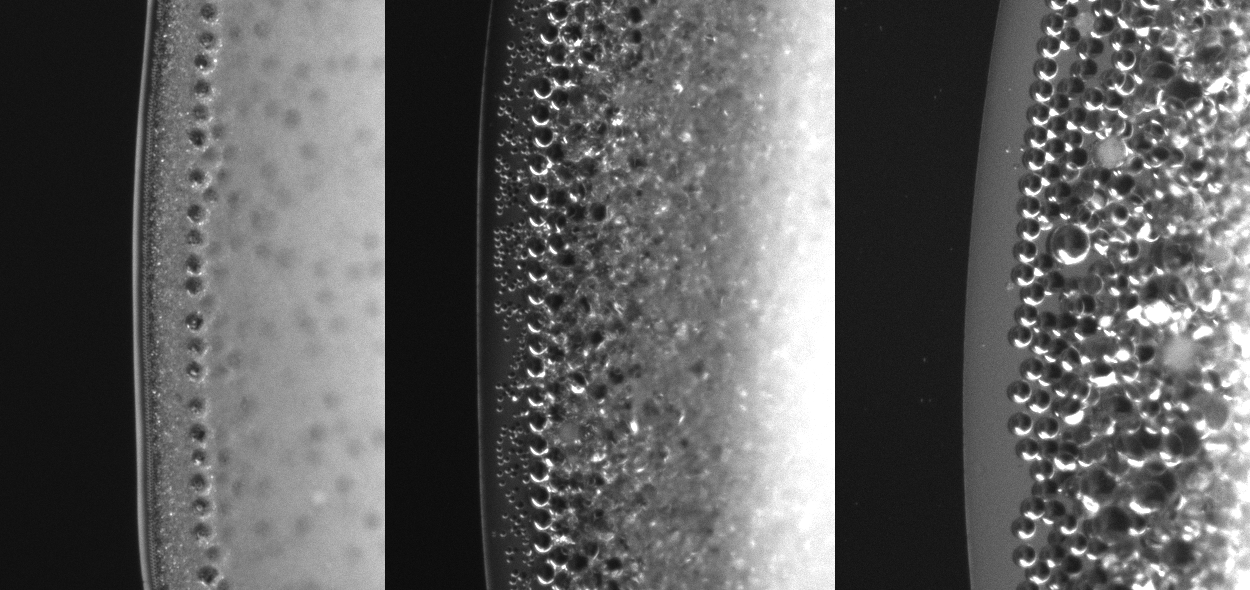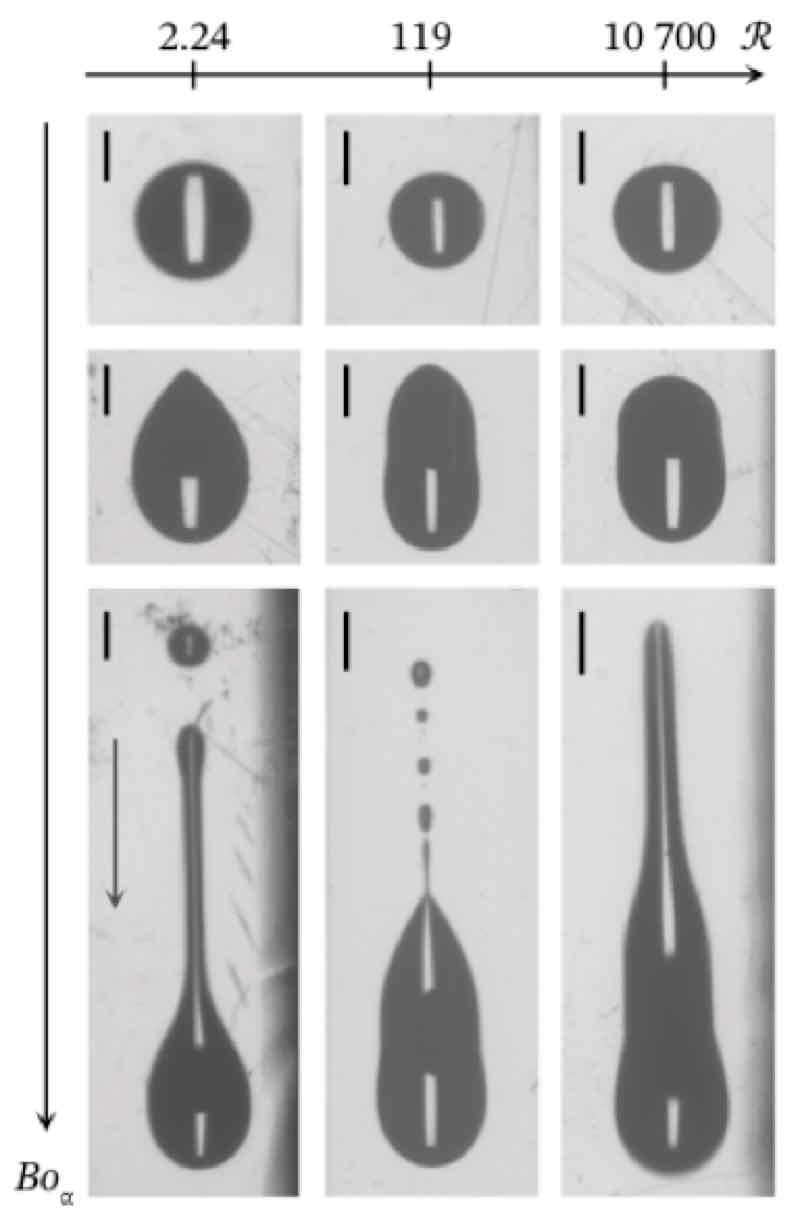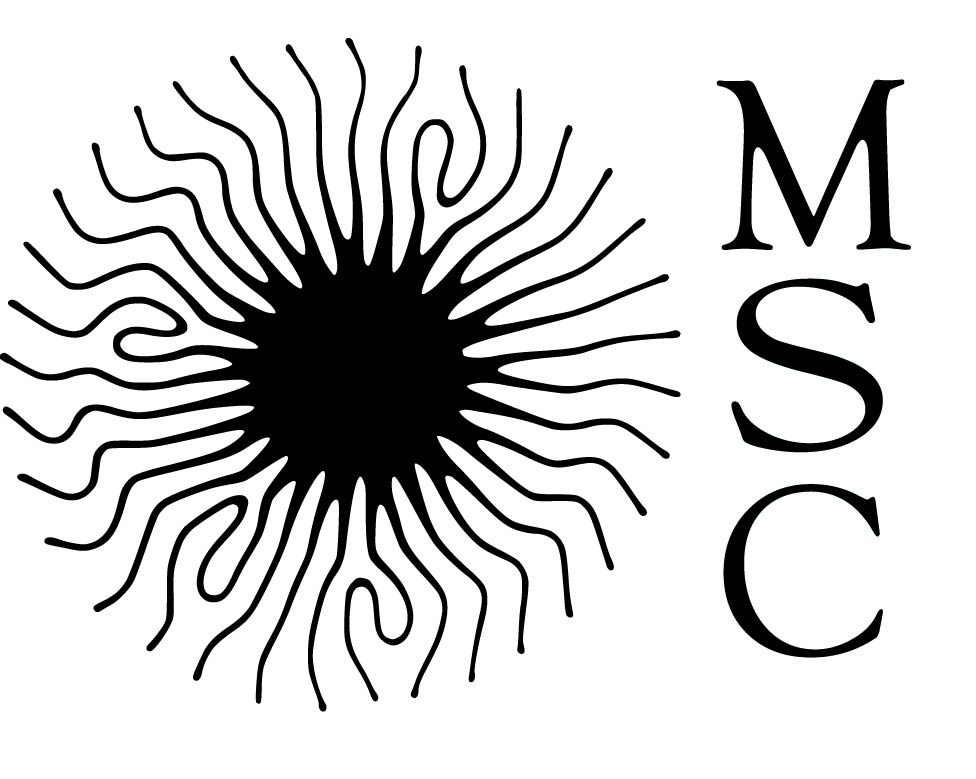Complex Fluids and Capillary Flows
DSHE
Research topics in this area include the rheology of complex fluids, dynamic wetting of suspensions, interface icing, or wetting in the presence of phase change and on complex, textured or soft substrates, using techniques such as fast imaging, far-field microscopy and the university’s clean room. The study of the micro- and nano-rheology of biological fluids is also incorporated into this axis.
Suspension wetting
This involves the spreading of drops from iso-density granular suspensions for mono- and bi-disperse suspensions. The relationship between dynamic contact angle and contact line velocity is similar to that of a simple fluid, despite the complexity introduced by the presence of particles. An apparent wetting viscosity of the suspensions can be defined, which differs from that measured in the volume.
Participants :
Elisabeth Guazzelli, Matthieu Roché, Laurent Limat.
Thesis of Alice Pelosse

Mooring on Soft Substrates
Wetting has long been studied, particularly when the solid in question is very rigid. The situation is different when a liquid wets a soft solid (typically a silicone gel). In particular, we are investigating the consequences of the deformability of the solid and its ability to dissipate energy with that of the liquid on the movement of contact lines, droplets and films.
Participants :
Julien Dervaux, Laurent Limat, Matthieu Roché.
Thesis of Mathieu Oléron et d’Anthony Varlet.

Caption: Drop shapes as they roll off a deformable viscoelastic substrate. The
dissipation changes from an isodistribution between solid and liquid (left column) to a distribution
only in the solid (right-hand column). Scale bar: 2 mm
Wetting on cold substrates
This research topic focuses on the coupling of liquid solidification with contact line dynamics, for example when a contact line (water-substrate-air) moves and solidifies at the same time. We studied this configuration in the case of a drop deposited on or impacting a cold substrate. In the case of a deposited drop, we have shown that ice crystals grow from the interior of the drop towards the contact line, until they catch up with it and trap it, bringing the spreading process to a halt. In the case of a drop impacting a cold substrate at high speed, we can accurately predict the influence of frost on splash triggering (drop fragmentation) by taking into account the microscopic effects of the presence of ice at the contact line.
Participants :
Philippe Brunet, Julien Dervaux, Axel Huerre, Laurent Limat
Thesis of Rémy Herbaut and post-doctorate of Pierre-Brice Bintein.

Legend: a) Hydrogel droplet freezing. b) Ice crystal formed during deposition of a droplet. c) Droplets impacting substrates at two different temperatures and fragmentation appearing.
Wetting, spreading and morphogenesis of bacterial colonies
Microorganisms have developed a wide range of techniques for propagating themselves in air, in liquids or on surfaces. A suspension of bacteria on the surface of a gel is able to push back the edge of the colony, whereas capillary forces are insurmountable by a single bacterium. In this way, we have discovered that they are capable of removing droplets from inclined surfaces. We are also studying another mode of colony spreading – mass swarming – in which the colony boundary is collectively pushed back, producing dendritic structures. This system couples thin-film hydrodynamics with the non-equilibrium physics of active/granular matter. We have developed a
profilometer to measure the solvent flux generated by bacteria in the gel, and simultaneously characterize the wetting conditions around the colony. We also have a high-resolution, multi-sample imager integrated into a climate chamber to monitor spreading dynamics.
Participants:
Adrian Daerr, Julien Tailleur (Théorie), Gaëlle Charron (Physique du vivant).
Thesis of Marc Hennes

Caption: (a) Dendritic spread of bacteria on the surface of a gel, from a central inoculum. (b) Front of a dendrite at high magnification, showing the sharp interface that delimits the swarm. (c) Capillary forces dominate flagellar forces by several orders of magnitude.
Marangoni flows
We are interested in Marangoni flows induced by water-soluble surfactants. At MSC, we have studied the mechanism leading to the generation of surface vorticity patterns observed outside these flows. We have shown that these patterns result from the reconnection of the vorticity produced in the volume of the water layer on which the surfactants are injected. This mechanism is particularly sensitive to the purity of the surfactant injected, as the presence of impurities prevents the observation of these patterns. We have also explored the relationship between the velocity of an object propelled by a surfactant-induced surface tension difference between its front and tail, and the physicochemical properties of the latter.
Participants :
Matthieu Roché
Thesis of Gabriel Le Doudic

Marangoni flow vortices, caused by the continuous injection of a surfactant onto the surface of a liquid.
Nanorhéologie intracellulaire des globules rouges : vers le suivi de pathologies érythrocytaires
Nous utilisons des rotors moléculaires, sondes fluorescentes de “viscosité” dans les globules rouges et développons une technique de nanorhéologie intracellulaire des globules, là où les techniques classiques de rhéologie et microrhéologie ne peuvent être mises en oeuvre. Dans le cas de pathologies érythrocytaires (coll: M. Marin, Y. Colin Aronovicz, C. Le Van Kim, Laboratoire Biologie Intégrée du Globule Rouge, UMR_S 1134, INSERM et Université Paris Cité,M. de Montalembert (Hôpital Necker)), affectant les propriétés mécaniques et la morphologie des globules, notre approche présente un intérêt pour le suivi clinique de patient.e.s, et pourrait compléter l’ektacytométrie, technique de référence de ces pathologies. Deux preuves de concept montrent que la nanorhéologie intracellulaire permet de quantifier la rigidité des globules rouges sains, variée par température ou inter-donneurs.
Participantes :
Bérengère Abou.
Thesis of Alice Briole (2019-2023).

Caption: We measure the average fluorescence intensity of the molecular rotor contained in the cells using epifluorescence (X100) (left). The rigidity of healthy red blood cells varies with temperature (middle) and as a function of inter-donor variability characterized by CCMH (right). In both cases, rotor fluorescence intensity increases with red cell stiffness, providing proof of concept and demonstrating good sensitivity of our technique. Around 300 to 400 globules are imaged per sample.
Acclimatization of the cuticular layer of ants and Anticontamination of aircraft by insects
The cuticular hydrocarbon layer (CHC) is a material covering all insects, with two vital functions: anti-drying and communication signal. Thanks to its CHC profile, which can contain over 100 different hydrocarbons, an insect can recognize an individual’s species, colony and genus. An effective CHC for sealing, requiring rather solid hydrocarbons to block evaporation, will not be optimal for communication requiring more volatile hydrocarbons. In collaboration with F. Menzel’s group (Mainz, Germany) and A.-C. Joël (Aachen, Germany), we are studying the link between acclimatization, the biophysical characteristics (rheology, phase) of CHC and its chemical composition. Our experimental results enable us to build new paradigms.
We measure the viscoelastic properties of the cuticular layer and provide the first experimental evidence that CHC on the insect is biphasic, both solid and liquid, over a wide temperature range. This contradicts the commonly accepted assumption that CHC is entirely solid on the insect, becoming liquid above a critical temperature. We show that a biphasic layer optimizes both communication and sealing functions. The fact that this layer is biphasic over a wide temperature range means that both functions are robust to climatic variations. During ant acclimatization, we suggest that there is thus a selection pressure to optimize communication and sealing.
At the same time, we have been exploring the rheological and adhesion properties of insect hemolymph, the invertebrate equivalent of blood, as part of the European Clean Sky STELLAR project in collaboration with Airbus. One of their concerns is to limit insect contamination of aircraft leading edges during take-off and landing. This leads to premature boundary layer transition, which in turn increases drag and fuel consumption. Within the consortium, with a view to proposing anti-contamination surfaces for insect secretion, we measured the microrheology of hemolymph on surfaces selected for anti-contamination, then mimicked insect adhesion to these surfaces in a wind tunnel.
Participant :
Bérengère Abou.

